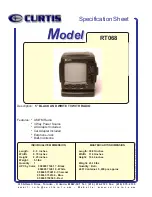
18
Gas Powered 3-in-1 Compressor / Generator / Welder
ground clamp, the electrode, and any metal parts
on the electrode holder.
2.
DO NOT TOUCH THE WELDING WIRE AND
THE GROUND
or grounded workpiece at the
same time.
3.
WEAR DRY PROTECTIVE CLOTHING:
coat,
shirt, gloves and insulated footwear. Do not touch
live electrical parts or electrodes with bare skin,
gloves or wet clothing. Do not weld if any part of
your clothing or body is wet.
4.
DO NOT WELD IN A DAMP ENVIRONMENT
or come into contact with a moist or wet surface.
5.
DO NOT ALLOW THE WELDING
EQUIPMENT TO COME INTO CONTACT
WITH ANY WATER OR MOISTURE.
6.
DO NOT DRAG THE WELDING CABLES,
THE ELECTRODE HOLDER, OR THE
WELDER’S POWER CORD THROUGH NOR
LET THEM COME INTO CONTACT WITH
ANY WATER OR MOISTURE.
7.
DO NOT TOUCH THE WELDER NOR
ATTEMPT TO TURN WELDER ON OR
OFF, IF ANY PART OF YOUR BODY OR
CLOTHING IS MOIST
or if you are in actual
physical contact with water or moisture.
8.
DO NOT CONNECT THE WELDER
WORKPIECE GROUND CLAMP
to or weld on
electrical conduit.
9.
NEVER USE THE WELDER TO THAW
FROZEN PIPES.
10.
DO NOT MAKE ANY CHANGES TO THE
POWER CORD
or the power cord plug in any
manner.
11.
DO NOT TRY TO PLUG
the welder into any
power source if the ground prong on power cord
plug is bent, broken off, or missing.
12.
DO NOT ALLOW THE WELDER TO BE
CONNECTED TO ANY POWER SOURCE
or attempt to weld if the welder, welding cables,
welding site, or welder power cord are exposed
to any form of atmospheric precipitation, or to
salt water spray.
13.
LAY OUT COILED OR TANGLED WELDING
CABLE BEFORE USE
in order to avoid
overheating and consequent damage to
insulation.
14.
DO NOT CARRY OR HOLD COILED
WELDING CABLES AROUND YOUR
SHOULDERS
, or any other part of your body,
when the cables are plugged into the welder.
15.
DO NOT MAKE ANY MODIFICATIONS
to any
wiring, ground connections, switches, or fuses in
this welding equipment.
16.
WEAR DRY WELDING GLOVES
to help
insulate hands from welding circuit.
17.
KEEP ALL CONTAINERS OF LIQUIDS FAR
enough away from the welder and work area so
that if spilled, those liquids cannot possibly come
into contact with any part of the welder or any
part of the electrical welding circuit.
18.
INSPECT ALL CABLES AND CORDS FOR
ANY EXPOSED WIRE
. and If found, replace
any cracked, abraded, or damaged parts such
as welding cables, power cord, or electrode
holder that are insulated or act as insulators
IMMEDIATELY, using only recommended
replacement cables and cords.
19.
NEVER ATTEMPT ANY REPAIRS OR
MAINTENANCE
on the welder while it is
connected to power.
20.
ALWAYS ATTACH GROUND CLAMP TO THE
WORKPIECE OR WORK TABLE AS CLOSE
TO THE WELD AS POSSIBLE
to prevent any
unknown, unintended paths of electrical current
from causing electrical shock and fire hazards.
Fumes and Gases
Fumes, gases, and vapours
may be very hazardous to
your health. They can cause
discomfort, illness and death!
In addition, fumes emitted from
the welding process displace
clean air and so can produce injury or death.
1.
TO REDUCE THE RISK OF DISCOMFORT,
ILLNESS, OR DEATH
, read, understand, and
follow the following safety instructions. Do not
inhale the fumes emitted by the welding process.
Make sure your breathing air is clean and safe.
Make certain as well, that anyone else that uses
this welding equipment or is a bystander in the
welding area understands and follows these
safety instructions.
2.
WELD ONLY IN A WELL-VENTILATED AREA
or use a ventilation device to remove welding
fumes from the environment where you will be
working. Do not weld in any area until it has been
checked for sufficient ventilation in accordance
with ANSI standard# Z49.1. If ventilation is found
not adequate to exchange all fumes and gases
generated during welding with clean, fresh air,
do not weld unless you, the operator, and all
bystanders wear air-supplied respirators.
3.
DO NOT WELD, CUT, OR EVEN HEAT LEAD,
ZINC, CADMIUM, MERCURY, BERYLLIUM
,
or similar metals without seeking professional
advice and inspection of the welding area. These
metals will produce extremely toxic fumes which
can cause symptoms ranging from discomfort
and illness up to and including death.
4.
DO NOT HEAT METALS THAT MAY BE
COATED WITH OR CONTAIN, MATERIALS
THAT PRODUCE TOXIC FUMES
(such as
galvanized steel, paint, galvanized, cadmium-
plating or containing zinc, mercury, chromium,
graphite, lead, cadmium, beryllium, or barium);
unless coated and that coating is removed.
They will emit fumes that are very dangerous
to breathe. Make certain the operator and all
bystanders are wearing air-supplied respirators.
Refer to the MSDS (material safety data sheet)
for the manufacturer’s instructions.














































